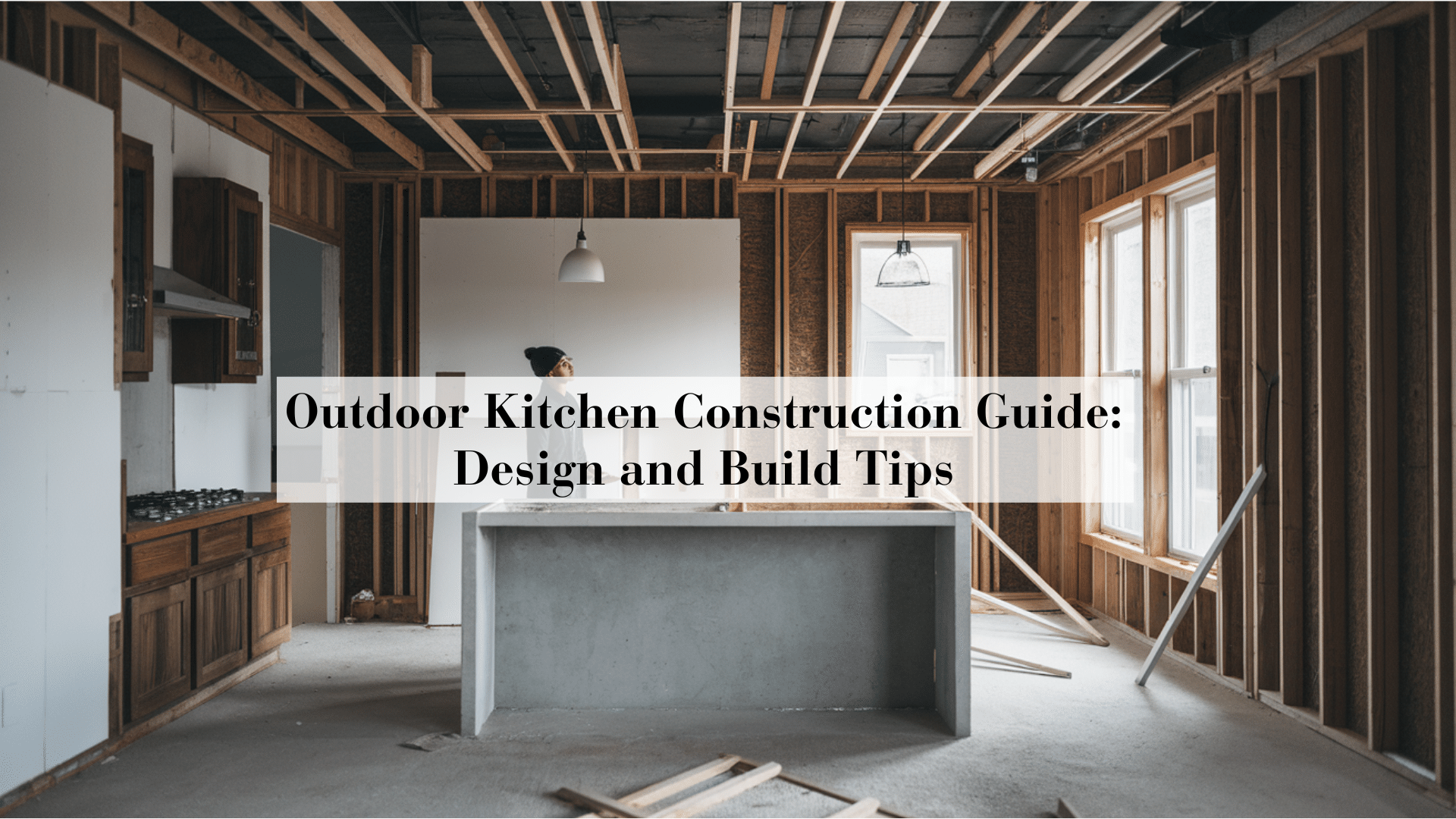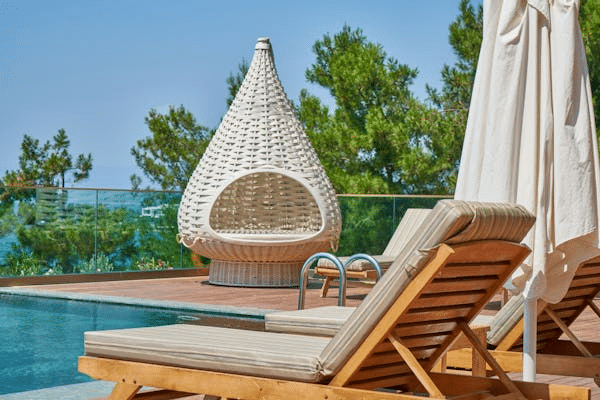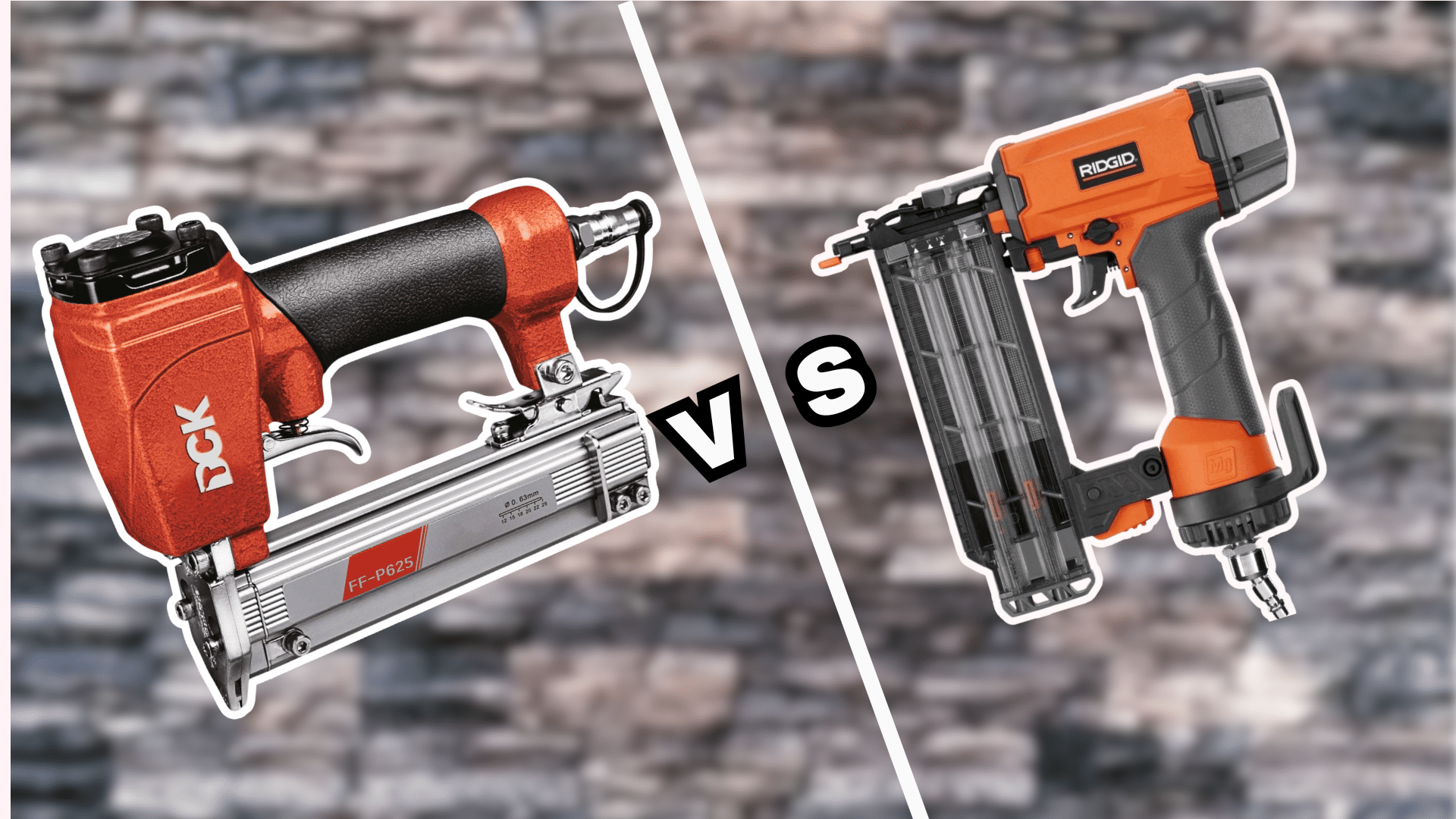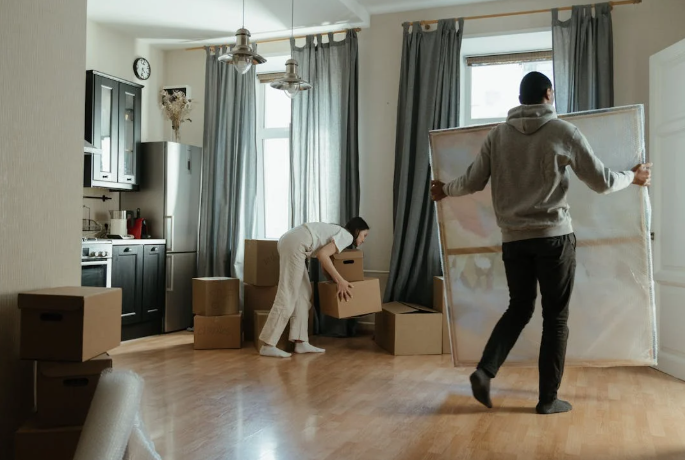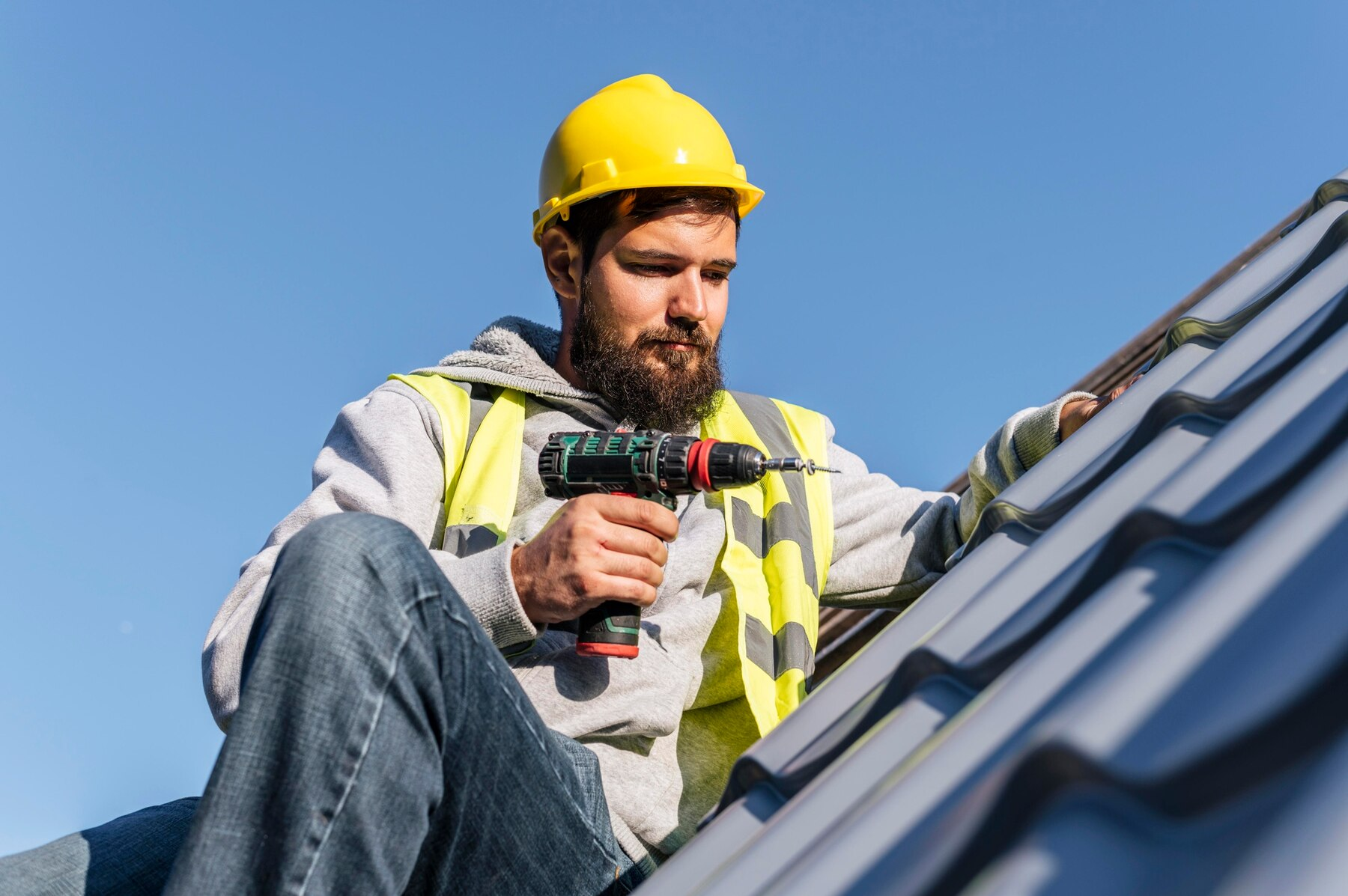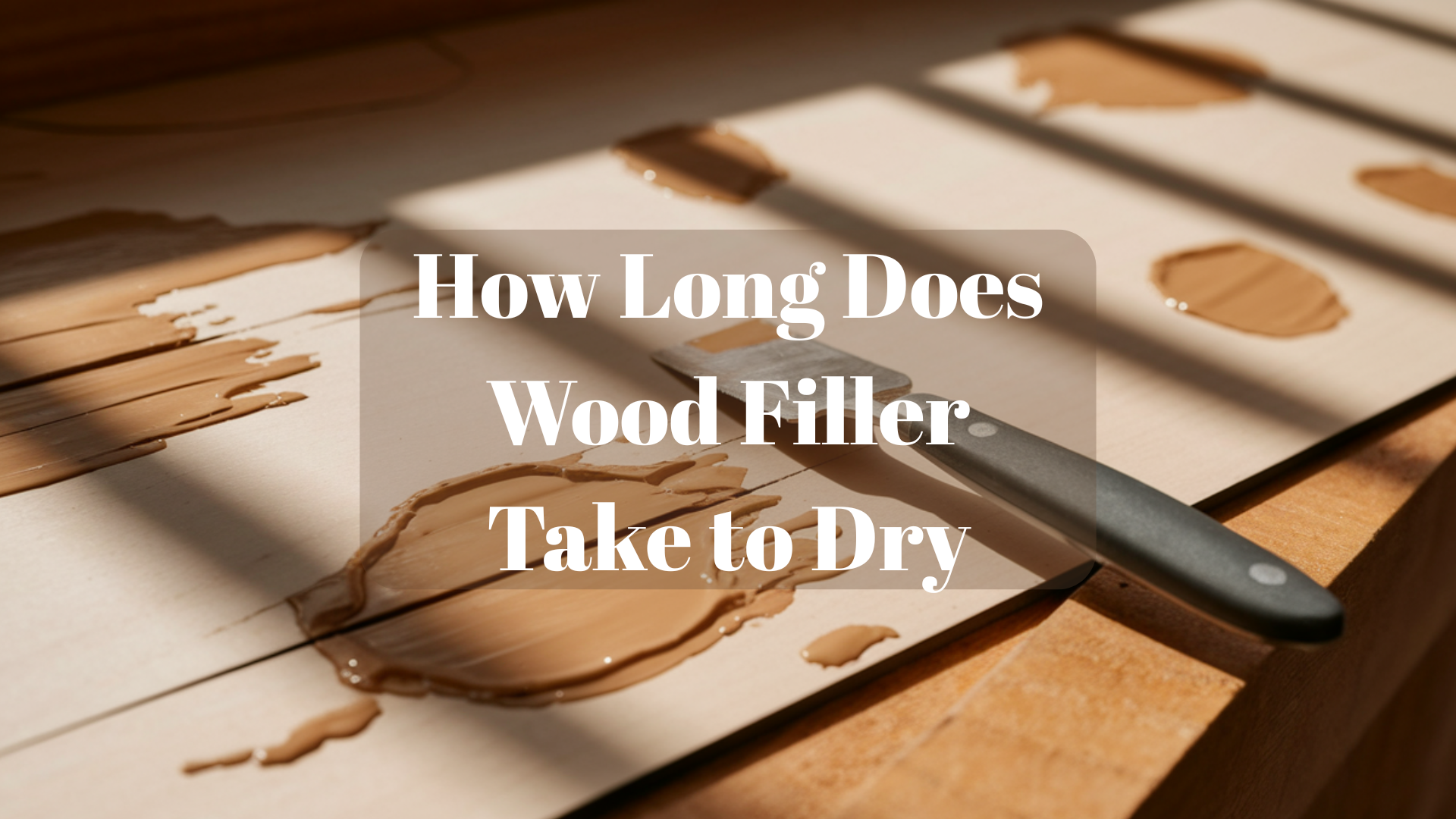Outdoor Kitchen Construction Guide: Design & Tips
Building an outdoor kitchen can add significant value to your home while making your backyard more useful.
Many homeowners find that cooking outside saves time and makes outdoor gatherings more fun.
An outdoor food prep area lets you stay connected with guests instead of running back and forth to the house.
When planning this project, you likely have questions about costs, needed materials, and how to get started.
The price can vary widely based on the size, materials, and features you choose. Basic setups might cost a few thousand dollars, while custom builds can go much higher.
This guide explains everything you need to know about creating the perfect outdoor cooking space for your home.
Why Build an Outdoor Kitchen?
Creating an outdoor kitchen combines beauty and function in your yard.
It expands your living space and changes how you use your outdoor area, turning simple backyard gatherings into memorable cooking experiences.
Benefits of an Outdoor Kitchen
Adding an outdoor kitchen brings several advantages. It makes hosting easier as you can cook while staying with your guests.
The experience of outdoor cooking adds to the fun of gatherings.
A well-built outdoor kitchen can increase your property’s value. Many buyers see it as a desirable feature that makes your home stand out.
It adds usable living space without changing your home’s main structure.
Cooking outdoors also helps keep your main house cooler during summer, potentially lowering energy costs.
Popular Outdoor Kitchen Features
The heart of any outdoor kitchen is the grill. Options range from basic gas grills to high-end models with special cooking zones.
Good countertop space is essential for food prep. Materials like concrete, stone, or outdoor-rated surfaces work best for weather resistance.
Storage cabinets keep utensils and tools handy and protected. Weather-resistant cabinets will last longer than indoor types.
Sinks make cleanup convenient without trips inside. Outdoor refrigerators keep drinks and food cold and easily available.
Planning Your Outdoor Kitchen Construction
Careful planning before starting construction will save you time, money, and frustration.
A thoughtful design ensures your outdoor kitchen meets your needs and fits well with your existing space.
Design Considerations
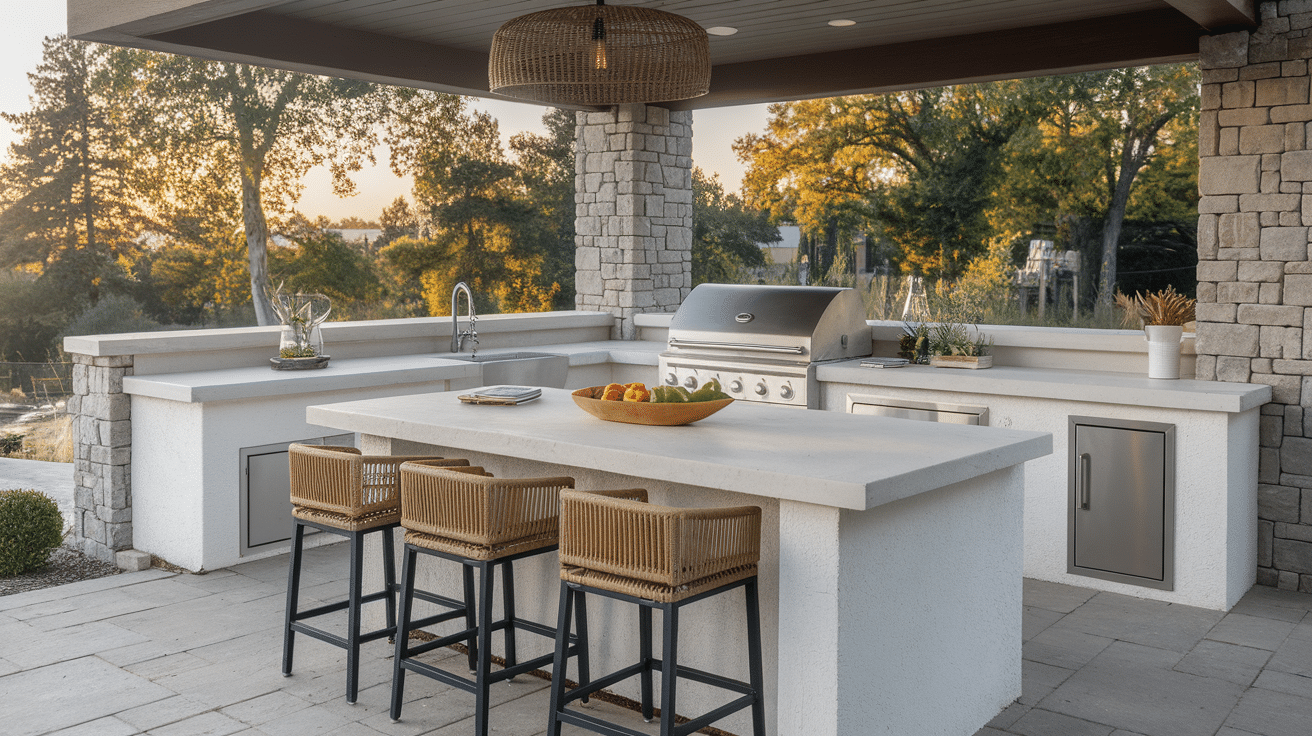
A well-designed outdoor kitchen balances aesthetic appeal with practical functionality.
Creating a space that enhances your outdoor living experience while supporting your cooking needs.
1. Layout Options
The shape of your outdoor kitchen affects both function and flow:
- Island-style works well in open spaces, placing the cooking area in the center where guests can gather around
- L-shaped designs fit nicely in corners or against walls, offering good workflow with separate zones
- U-shaped layouts provide maximum counter space and storage but require more room
- Compact designs work in smaller yards, focusing on essential elements like a grill and minimal prep space
2. Flow and Function
Think about how you’ll use the space when cooking. Place the grill where smoke won’t blow toward seating areas.
Keep prep areas next to cooking zones, and make sure there’s enough room for multiple people to move around comfortably.
Consider creating distinct zones for preparing, cooking, and cleaning.
This helps avoid bottlenecks when several people use the kitchen at once.
3. Placement and Positioning
The location of your outdoor kitchen matters. Placing it close to your indoor kitchen makes it easier to transport items back and forth.
However, not too close that smoke enters your home.
Consider sun patterns throughout the day. You might want morning sun but afternoon shade.
Also, think about views – both what you’ll see while cooking and how the kitchen looks from other areas of your yard.
Setting a Budget
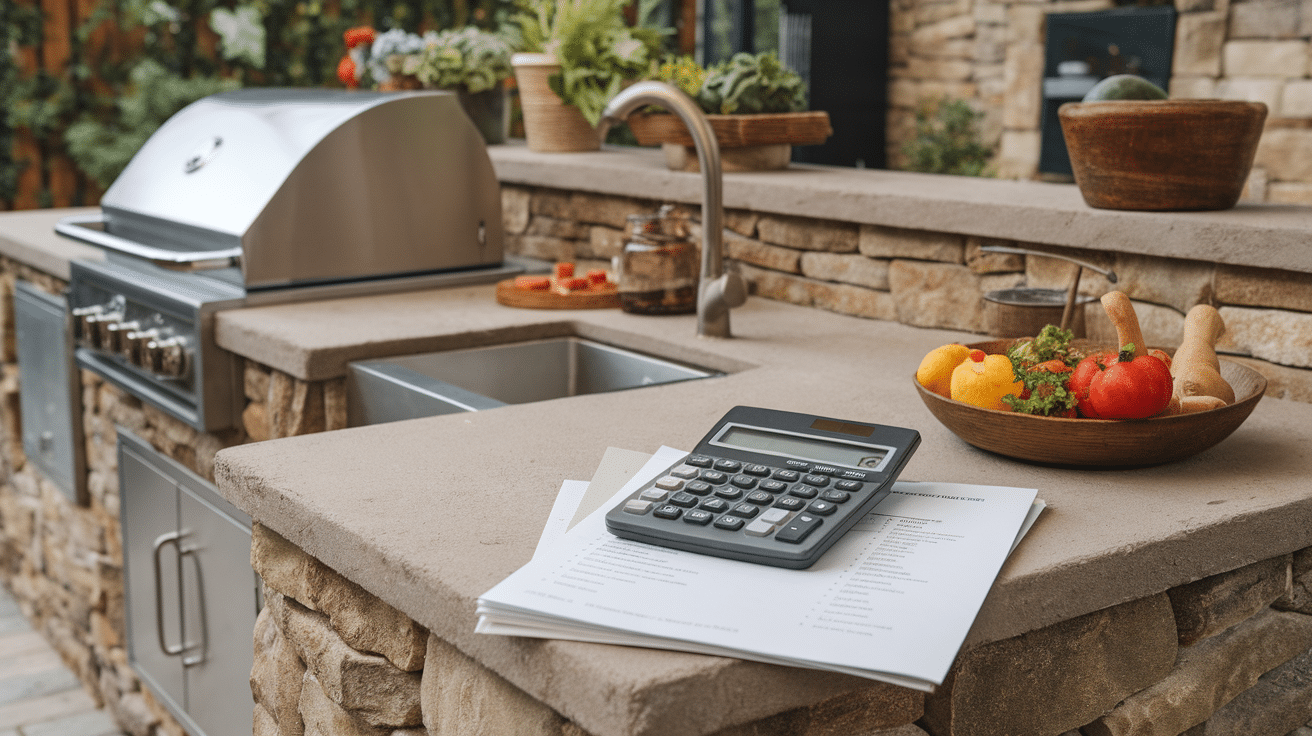
1. Cost Breakdown
An outdoor kitchen budget typically includes:
- Materials: Framework, countertops, and finishing materials
- Appliances: Grill, refrigerator, side burners
- Labor: If hiring professionals
- Permits: Check local building codes
- Utilities: Running gas, water, and electrical lines
Basic outdoor kitchens start around $2,000-$4,000 for DIY projects, while custom builds can reach $15,000 or more.
2. How to Save Money
Several strategies can help control costs:
- Use concrete blocks instead of custom stonework
- Choose pre-made components rather than custom cabinets
- Do some work yourself, like basic framing or finishing
- Pick multi-purpose appliances instead of many specialized ones
- Build in phases, starting with essentials and adding features later
- Look for floor models or last year’s appliances at discount prices
- Use existing structures when possible, like building against an existing wall
Materials for Outdoor Kitchen Construction
Selecting the right materials is crucial for building an outdoor kitchen that will last through years of weather exposure and use.
Choosing the Right Frame Material
The frame provides structure and support for your outdoor kitchen.
Wood frames are affordable and DIY-friendly but need treatment against moisture and insects.
Metal frames offer excellent strength and longevity, with aluminum resisting rust better than steel.
Concrete block frames provide maximum durability and fire resistance, though they’re heavier and take longer to build.
Countertop Materials
Outdoor countertops must withstand food prep, hot cookware, and weather changes.
Granite offers excellent heat resistance and unique patterns but needs yearly sealing.
Concrete can be customized in shape and color at a lower cost.
Stainless steel matches appliances, resists heat, and cleans easily but can get hot in sunlight.
Tile provides color variety and affordability, though grout requires more maintenance.
Flooring and Wall Materials
For flooring, look for non-slip surfaces that drain well.
Textured concrete, pavers, outdoor-rated porcelain tile, and natural stone all work well.
Wall materials should complement your design while resisting weather.
Stone veneer creates a premium look; brick offers classic durability; stucco provides smooth finishes at a lower cost; and metal panels add modern style.
Choose all materials based on your local climate conditions to ensure maximum durability and performance.
Guide to Building an Outdoor Kitchen
Building your outdoor kitchen becomes manageable when broken down into clear steps.
Here’s how to tackle this project efficiently.
Step 1: Preparing the Site
Select the ideal location, considering proximity to your house, view, and sun exposure.
Using concrete, pavers, or reinforced decking, create a solid foundation that can support your structure’s weight.
Ensure proper slope for drainage and check that the surface is completely level before proceeding.
Step 2: Building the Frame
Construct your frame using your chosen material. Wood frames are DIY-friendly but need weather protection.
Metal offers strength but requires specific skills. Concrete blocks provide durability and fire resistance.
Include precise cutouts for your appliances and secure the frame firmly to your foundation.
Step 3: Installing Utilities
Run gas, water, and electrical lines before closing up the walls.
Have gas lines installed by certified professionals. Include shut-off valves for water lines and ensure proper drainage.
Install GFCI electrical outlets following local codes, adding extras for future needs.
Step 4: Adding Surfaces and Appliances
Apply weather-resistant sheathing before adding exterior finishes.
Install and seal your countertops, then add your grill, sink, and other appliances.
Secure all cabinets and storage areas with outdoor-rated fasteners and sealants.
Step 5: Finishing Touches
Complete the kitchen with task lighting for cooking areas and ambient lighting for evening use.
Add functional elements like tool hooks and towel bars.
Apply final sealants to all surfaces and establish a maintenance routine to protect your investment.
Outdoor Kitchen Maintenance and Longevity
Regular maintenance keeps your outdoor kitchen working properly and looking good for years to come.
Tips for Cleaning and Caring for Appliances
- Clean your grill after each use by burning off food residue and brushing the grates when cool.
- For stainless steel, wipe with mild soap in the direction of the grain, then dry completely.
- Use covers for all appliances when not in use.
- Empty and clean outdoor refrigerators regularly and check door seals.
- Clean sinks frequently to remove mineral deposits, using vinegar for tough buildup.
General Care Tips
- Apply fresh sealant to countertops annually, especially for porous materials.
- Check caulking around sinks and joints yearly and replace it as needed.
- Consider adding a roof or pergola for maximum protection.
- Good-quality covers help extend the life of both individual appliances and the entire kitchen.
- Inspect your frame annually for water damage, rust, or insect activity to prevent major repairs later.
Seasonal Maintenance
- In cold regions, shut off and drain water lines before winter.
- If possible, remove smaller appliances and cover built-in items according to manufacturer guidelines.
- Clean all surfaces, apply protective coatings, and secure covers before winter.
- Have gas lines professionally checked yearly.
- In spring, inspect for winter damage and test all appliances and utilities before the cooking season begins.
Cost-Effective Tips for Building an Outdoor Kitchen
1. Budget-Friendly Design Ideas
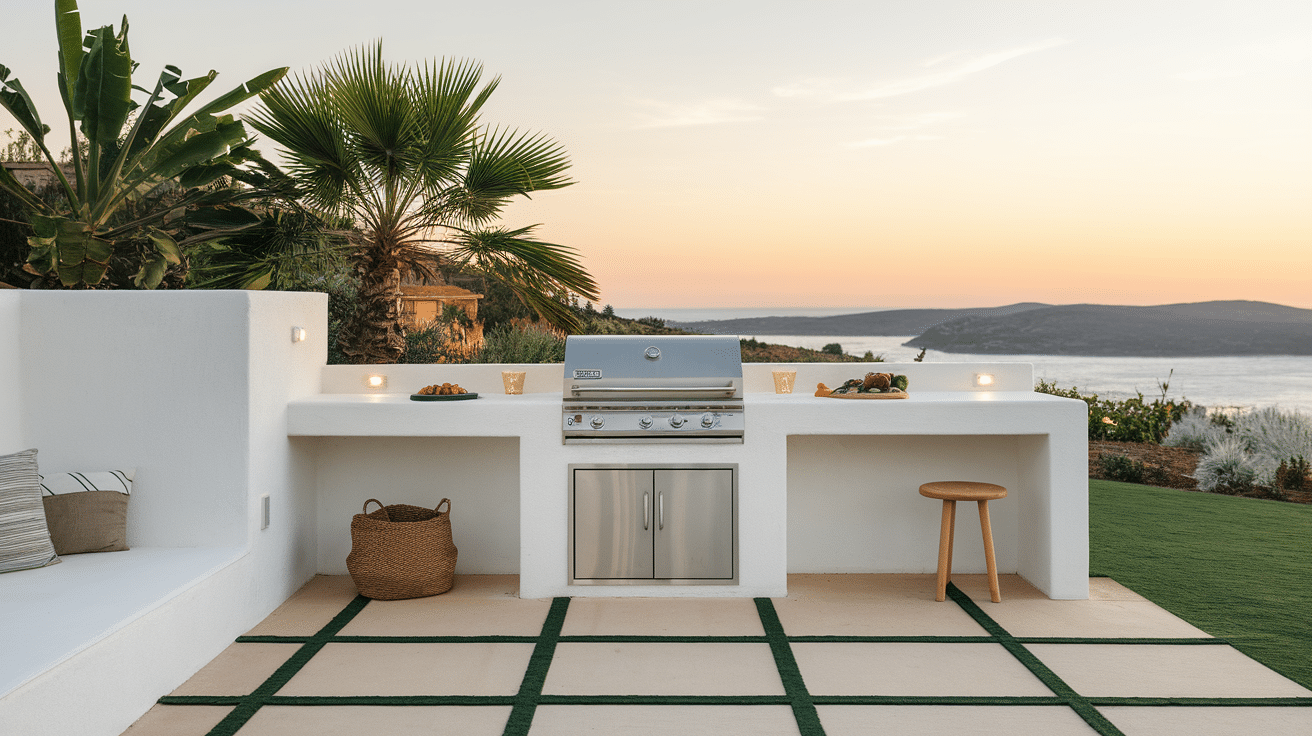
Keep your design simple with just the essentials – a good grill and prep space.
Consider a modular approach where you build in phases as budget allows.
Use premium materials only where visible and less expensive options elsewhere.
Look into pre-built kitchen kits, which often cost less than custom builds while providing quality results.
2. DIY vs. Professional Construction
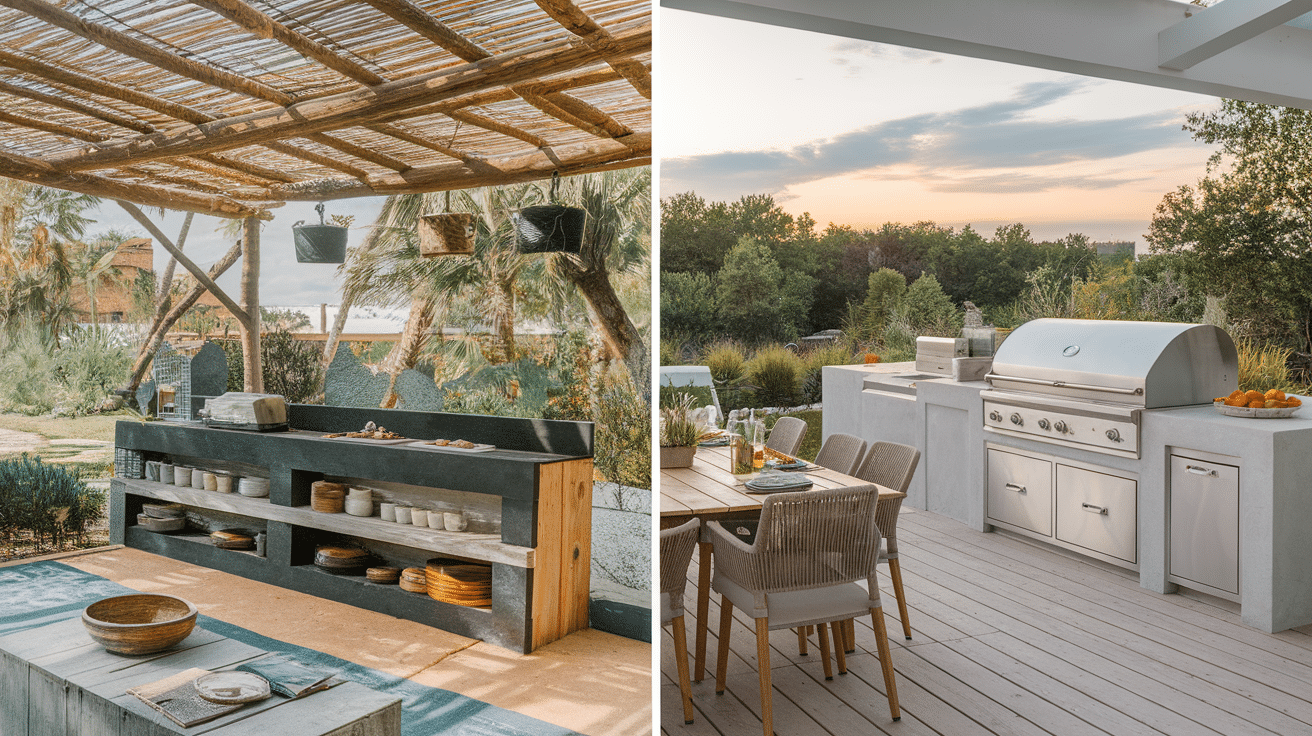
Handling simpler tasks yourself, like basic framing and finishing work, can save significantly on labor costs.
However, always hire professionals for gas lines, electrical work, and plumbing for safety and code compliance.
A mixed approach often works best – professionals for complex elements and DIY for the rest.
3. Sourcing Affordable Materials
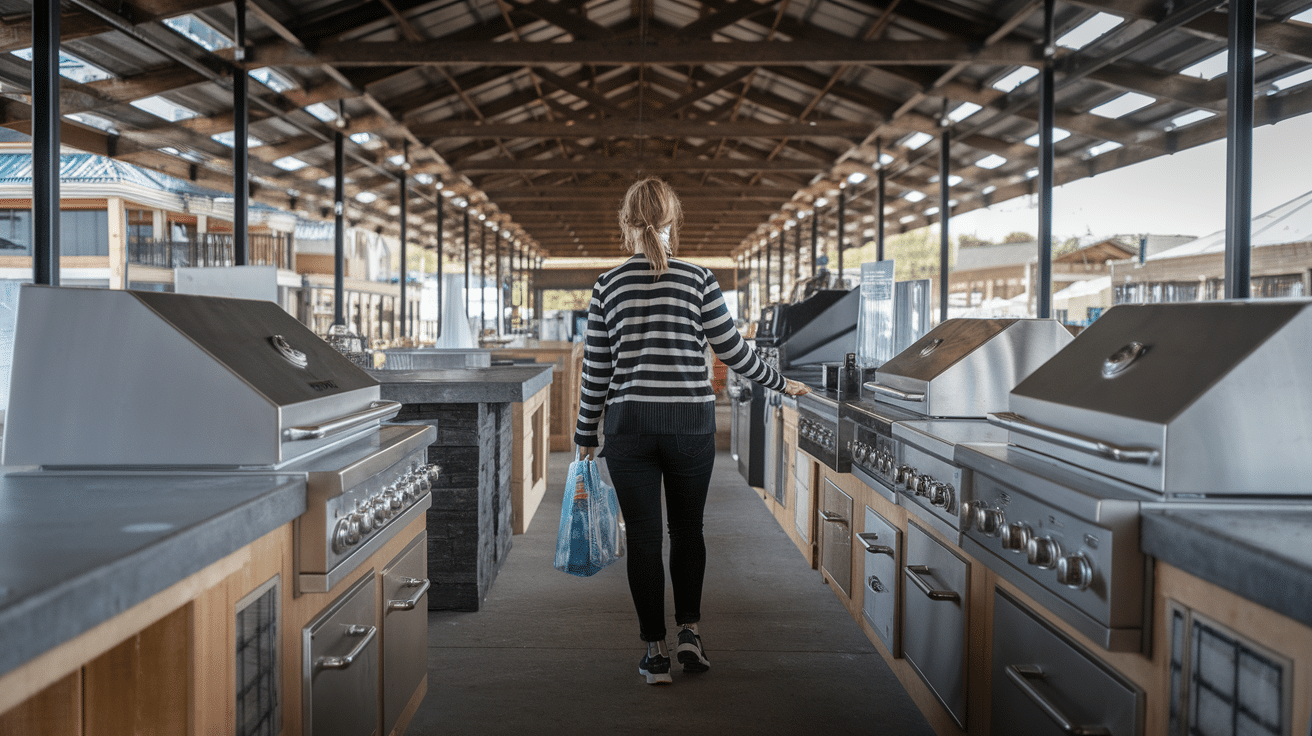
Check building supply auctions, restaurant supply liquidations, and online marketplaces for deals on appliances and materials.
Consider concrete countertops as an affordable alternative to natural stone.
Look for floor models or last year’s appliances at discount prices.
Shop during off-season sales when outdoor items are typically marked down.
Conclusion
Start with a clear vision of how you’ll use the space, create a realistic budget, and select durable materials that fit your climate.
Whether you build it yourself or hire professionals, focus on quality in areas that matter most—like the grill and countertops.
Regular maintenance will keep your outdoor kitchen looking great and functioning properly for years.
Even on a limited budget, you can create an outdoor cooking space that enhances your home and outdoor living experience.
Ready to start planning? Begin by sketching your ideal layout and researching materials that match your needs.

